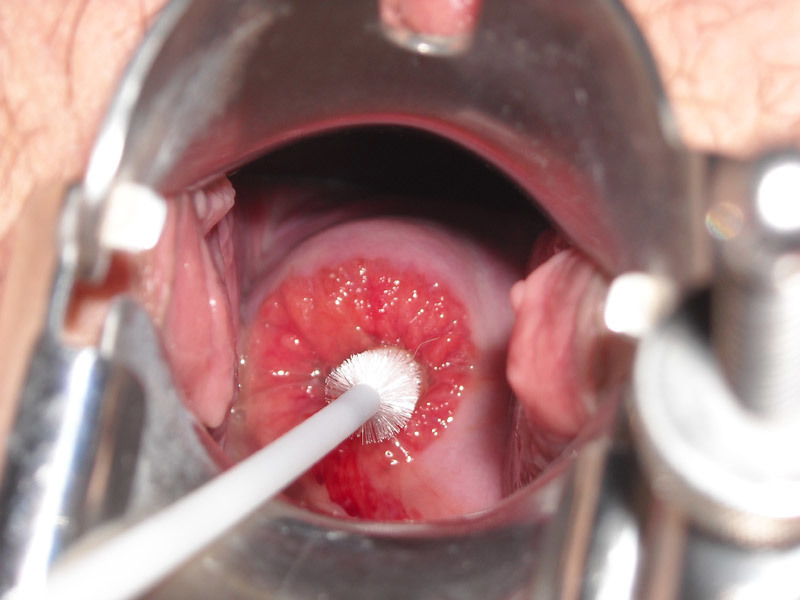Cervical dysplasia is a dangerous disease of the female genitalia, the progression of which can lead to degeneration into cancer.
Contents
- Symptoms of cervical dysplasia
- Video: What is cervical dysplasia and what should I do with it?
- Causes of cervical dysplasia
- Prophylaxis of cervical dysplasia
- Cervical dysplasia
- Diagnosis of cervical dysplasia
- Can cervical dysplasia be cured?
- Drugs for the treatment of cervical dysplasia
- Treatment of cervical dysplasia folk remedies
- Is it possible to relapse cervical dysplasia?
- Cervical dysplasia and pregnancy
- Nutrition for cervical dysplasia
- Video: Cervical dysplasia. How to stop cancer?
According to statistics, cervical cancer is the number one disease by mortality among the female population.
In European countries, this type of cancer is affected by 11.5% of women , which makes it the most common oncological disease. This deadly pathology of is preceded by dysplasia of the cervix , which is absolutely asymptomatic.
Symptoms of cervical dysplasia
Cervical dysplasia is a disease characterized by the formation of atypical cells on the lower part of the uterus.
Dysplasia alone does not endanger the life of a woman, but the risk of her degeneration into cancer is very high, which makes pathology potentially dangerous. According to statistics, the diagnosis of "cervical dysplasia" is annually put 40 million women throughout the world.
 Cervical dysplasia
Cervical dysplasia Often dysplasia is confused with with cervical erosion , which is characterized by mechanical damage to epithelial cells. When cervical dysplasia cells are modified, usually without affecting the upper ball and its shell. Correct and timely diagnosis is the key to the effectiveness of treatment of the disease.
Cervical dysplasia is asymptomatic and it is possible to assume its presence only during gynecological examination. Precisely establish that there is dysplasia, and not cervical erosion, only PAP smear can. Very rarely, in 1% of patients, visible symptoms can occur, such as genital warts.
Although cervical dysplasia does not signal itself for a long time, in many women it is accompanied by various inflammatory diseases of , such as colpitis and cervicitis. Painful sensations, discomfort and itching, which bring these pathologies, make a woman turn to a specialist - this is what helps to identify tissue dysplasia, which the patient did not even guess.
 Inflammatory process that may accompany
Inflammatory process that may accompany dysplasia For the dysplasia of the cervix, the following signs are typical:
- increase in the size of the epithelial cells, the formation of several nuclei in them
- the flow of the cells of the intermediate layer
- frequent presence of background disease( inflammatory or STD)
Absence of symptoms in the early stagesdysplasia leads to the fact that the disease successfully flows into a more severe stage, the treatment which is often only surgical.
Video: What is cervical dysplasia and what should I do with it?
Causes of cervical dysplasia
Both internal and external factors contribute to the atypical development and structure of cervical cells. Specialists identify such causes of cervical dysplasia:
- long-term oral contraceptive use
- early sexual experience( up to 18 years)
- disordered communication with many sexual partners
- disease with papilloma virus
- bad habits: alcoholism and tobacco use
- multiple births accompanied by cervical damage
- hereditary predisposition
- chronic inflammatory processes
- immunodeficiency states(with AIDS, diabetes)
- abortion
- neglect of basic rules of personal hygiene
 zling sex life - one of the main causes of atypical transformation cervical cells
zling sex life - one of the main causes of atypical transformation cervical cells Thus, the risk of cervical dysplasia disease have all women and even girls who are sexually active. An early role in the origin of atypical cells is played by the earlier beginning of the sexual life of , because at this time the mucous membrane of the vagina and glands are not fully formed and can not fully perform their protective functions.
Prevention of cervical dysplasia
To prevent dysplasia of the cervix, it is impossible - there are no drugs or vaccines that protect against this disease. But can significantly reduce the risk of of its appearance due to a correct lifestyle and regular visits to the gynecologist.
 Regular visit to a gynecologist is the guarantee of female genital health
Regular visit to a gynecologist is the guarantee of female genital health The regularity of the examination for the diagnosis of dysplasia and cervical cancer:
- Through 3 years after the onset of sexual activity or after is reached 21 years
- If previous PAD tests were negative, a second examination is necessary to pass through every 2 years
- For women who have reached the age of 30 and older, the survey should be carried out at least once in the 3oda
- Women after 70 years of can be stopped regular examinations if during the 10 years of the test results were negative
- Women who had been removed from the uterus should not be examined
In addition to the tests, the should follow the following prevention rules:
- rejection of bad habits
- food should include vitamins( E, A, C, B group)
- personal hygiene compliance
- ordered sexual life
- rejection of hormonal contraceptive methodsand
- timely treatment of inflammatory diseases of the genital area
- administration of immunomodulators
 Prevention and examination of a specialist significantly reduces the risks of atypical changes in the cervix
Prevention and examination of a specialist significantly reduces the risks of atypical changes in the cervix Cervical dysplasia stages
If prevention methods do not help in preventing cervical dysplasia timely detection of will be the key to success.
Development of the atypical condition of the cervix is gradual, passing certain stages, which are characterized by the severity of the pathology.
The following stages of dysplasia are distinguished:
- Weak degree of - cell changes cover one-third of the basal layer of the epithelium, and signs of papillomavirus infection are pronounced. Diagnosis is difficult, but possible
- The average degree of - changes in cervical cells are more pronounced.50% of the epithelium is affected by atypical changes
- Severe degree of - pathological process is well pronounced, there are a lot of hyperchromic cell nuclei. Two-thirds of the surface of the cervix is susceptible to changes in the
 Degree of development of dysplasia and its transition into cervical cancer
Degree of development of dysplasia and its transition into cervical cancer Detection of cervical dysplasia at any stage of the does not indicate the imminent onset of cancer. Oncology is one of the risks of further development of the disease, but no one with a clear certainty can not say that the altered cells will not begin to aggressively divide and penetrate into neighboring tissues.
Cervical dysplasia has this prediction:
- in 1% in women with low-grade dysplasia, it passes into medium or severe dysplasia
- , moderate dysplasia in 16% of of women passes into medium-grade disease in 2 years, 25% - within 5 years
- 32% patients with severe cervical dysplasia face
cancer The risk of degeneration of dysplasia into cervical cancer is significant, therefore should not be allowed to fall ill on its own, hopingabout the worst you will pass. Timely diagnosis can save your life.
 Cervical cancer
Cervical cancer Diagnosis of cervical dysplasia
If you are diagnosed with as the diagnosis of "cervical dysplasia" when you are examined on a gynecological chair, run away from such a specialist. With the help of an elementary examination, only a gynecologist with extrasensory abilities can reveal atypical cells, and professional diagnostics should necessarily include:
- Cytology test
- Colposcopy
- Biopsy( if necessary)
Cytology or PAD test - scraping of the upper cell ball from the cervical canal and cervixuterus, which are studied in the laboratory.
The task of this test is to identify atypical cells that have an uncharacteristic structure and size for the cells of the upper globule of the cervix. As a rule, dysplasia is diagnosed by in 5% of the smears taken .
If necessary, the test is repeated, since at the initial stage of dysplasia a small part of the surface is affected, which makes diagnosis difficult.
 Smear sampling for cytology
Smear sampling for cytology Colposcopy is a cervical examination of a special device that increases and delivers an image to the monitor. Due to this non-contact and absolutely painless method of diagnosis, you can see an atypical mucosal surface.
 Colposcopy
Colposcopy - During colposcopy, a simple examination of the cervix can be performed, and sampling biomaterial for further investigation of
- . If a simple swab can take cells from a healthy area of the epithelium, and atypical ones remain unnoticed, then colposcopy is more likely to detectof the affected area and further investigation of its cells
- If colposcopy revealed altered areas, the doctor may prescribeit biopsy .This method of diagnosis is carried out under local anesthesia and is a sampling of a tissue fragment from a modified section of the
 Biopsy involves the study of cells of a biomaterial taken
Biopsy involves the study of cells of a biomaterial taken Biopsy is contraindicated in if there are any inflammatory processes. If there is an urgent need for this study, the biopsy is performed by against the background of antibiotic therapy.
Can cervical dysplasia be cured?
Cervical dysplasia often is called the precancer , but despite such a formidable name, it can be treated. Moreover, the medicine has developed enough to effectively treat cervical dysplasia. Their doctor will choose, depending on the degree of the disease and the specifics of its course.
If the development of atypical cells does not stop but continues to progress, the resorts to the following treatment methods:
- destruction by liquid nitrogen
- moxibustion( conization)
- laser burning
- surgery( in very severe cases)
 Surgical treatment of cervical dysplasia
Surgical treatment of cervical dysplasia Drugs for the treatment of cervical dysplasia
The most radical treatment for cervical dysplasia is the surgical intervention. It is resorted to only if all less invasive methods can not yield positive results.
Often, doctors choose as a waiting tactic for and follow the course of the disease without applying radical treatments.
At this stage can be assigned:
- immunomodulators
- vitamins
- selenium
- anti-inflammatory agents( if necessary)
- beta-carotene
 In the treatment of dysplasia, the importance of taking vitamins and immunomodulators
In the treatment of dysplasia, the importance of taking vitamins and immunomodulators Treatment of cervical dysplasia folk remedies
Folk medicine offers largethe number of recipes , designed to cure cervical dysplasia. There are no scientific data on their effectiveness, therefore the use should be agreed with the attending physician.
The most popular recipes are:
Nettle tampons
200 g of nettle leaves chop on a meat grinder and squeeze out the juice. In it, soak the tampon and place it in the vagina for 15 minutes. This procedure should be repeated for a month, no more than once a day.
 Nettle
Nettle Pine broth
Kidney buds chop and boil for 2 minutes, pre-filling the glasses with water. The resulting broth cool and let it brew for 2 hours. Use the remedy for a month for syringing.
 Pine buds
Pine buds Scarlet leaves
Scarlet leaf is well rinse and grind. Squeeze out the juice and soak it with a tampon, and then mark it in the vagina for 10 minutes. Repeat the procedure in the morning and in the evening for two to three weeks.
 Aloe
Aloe Sea buckthorn oil
You can make a tampon using sea buckthorn oil. You can buy it at any pharmacy - the cost of such a tool is very democratic. Tampons soaked in oil should be placed in the vagina for 10 minutes for a week, then take a week break and again repeat the course.
 Sea buckthorn oil
Sea buckthorn oil Is it possible to relapse cervical dysplasia?
Cure dysplasia, unfortunately, does not mean that you can forget about the disease forever. There is always a risk of recurrence, but it can be reduced to a minor mark. According to the specialists, the chance of relapse in many ways depends on the treatment and subsequent prevention:
- Medical treatment and cauterization of ( without follow-up preventive measures) - up to 40% of cases of relapse
- Surgical method - risk of return of dysplasia is 15%
- Comprehensive treatment of surgical method, drug treatment and prevention) - the risk of recurrence is not more than 3%
 Cervical dysplasia can return again
Cervical dysplasia can return again The possibility of recurrence of is influenced by otherFactors:
- age( the older the woman, the greater the probability of the return of cervical dysplasia)
- activity of the immune system( in the immunodeficiency state the risk is several times higher)
- the presence of chronic diseases
- hormonal background
Cervical dysplasia and pregnancy
Diagnosis of "dysplasia of the cervix" during pregnancy should not scare you. Of course, this condition is also dangerous for the body, but atypical changes in do not affect pregnancy in any way.
Similarly, pregnancy in no way can negatively affect the disease. In some cases, when severe dysplasia is observed, labor may occur prematurely.
If a woman has a severe degree of cervical dysplasia, then the delivery is performed by by caesarean section, because her natural birth is contraindicated.
 Dysplasia does not affect pregnancy
Dysplasia does not affect pregnancy During pregnancy , dysplasia is not treated with .It is postponed until delivery, but continues to observe the dynamics of development with the help of colposcopy. If a woman has cervical dysplasia degenerates into grade I cancer, , then she will be treated with an oncogynecologist.
Nutrition for cervical dysplasia
In addition to treatment for cervical dysplasia , a diet is also prescribed. Its goal is to prevent malignancy of the modified cells of the cervix, as well as saturation of the body with the necessary vitamins and trace elements.
Authorized and forbidden products of are indicated by the physician and the introduction of any ingredient or additive in the menu you must discuss with him.
A special diet is designed to ensure that the body receives sufficient amounts of beta carotene, vitamins B, A, E, C.
 All cruciferous are very useful for cervical dysplasia
All cruciferous are very useful for cervical dysplasia For dysplasia it is necessary to consume:
- cabbage, broccoli
- cherries, blueberries
- tomatoes and bell peppers
- meat, fish
- beans
- olive oil
- green tea
- 2.5 liters of water
From the ration it is necessary to exclude:
- alcohol
- desserts, sweets, fast food and margarine, having in their composition trns fats
- coffee
cervical dysplasia uterus - a dangerous disease, but it is not synonymous with cancer and not in all cases lead to it. Proper treatment, timely prevention and lifestyle change will help prevent the severe consequences of dysplasia and protect against oncology.
